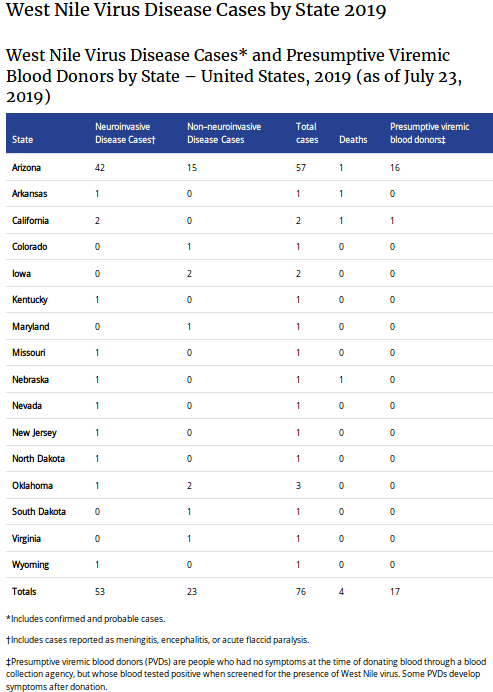#14,211
Although it no longer garners the kind of headlines it once did, West Nile virus (WNV) is the leading cause of mosquito-borne illness in the continental United States, and is believed responsible for tens of thousands of mild illnesses, and hundreds of deaths, each summer.
Nearly 3 months ago, in CDC: The 8 Zoonotic Diseases Of Most Concern In The United States, we looked at a joint CDC, USDA, DOI report on the top (n=56) zoonotic diseases of national concern for the United States (see chart below).
 |
| West Nile virus comes in #4 on their hit parade. |
The CDC describes the threat on their WNV webpage:
West Nile virus (WNV) is the leading cause of mosquito-borne disease in the continental United States. It is most commonly spread to people by the bite of an infected mosquito. Cases of WNV occur during mosquito season, which starts in the summer and continues through fall. There are no vaccines to prevent or medications to treat WNV in people. Fortunately, most people infected with WNV do not feel sick. About 1 in 5 people who are infected develop a fever and other symptoms. About 1 out of 150 infected people develop a serious, sometimes fatal, illness. You can reduce your risk of WNV by using insect repellent and wearing long-sleeved shirts and long pants to prevent mosquito bites.West Nile Virus seasons vary wildly from year-to-year, with big swings not only in the number of serious infections reported, but also in the localities hardest hit. In 2012 – the deadliest year on record for West Nile deaths thus far – the CDC reported:
Final 2012 West Nile virus update:
In 2012, all 48 contiguous states, the District of Columbia, and Puerto Rico reported West Nile virus infections in people, birds, or mosquitoes. A total of 5,674 cases of West Nile virus disease in people, including 286 deaths, were reported to CDC.
Of these, 2,873 (51%) were classified as neuroinvasive disease (such as meningitis or encephalitis) and 2,801 (49%) were classified as non-neuroinvasive disease. The numbers of neuroinvasive, non-neuroinvasive, and total West Nile virus disease cases reported in 2012 are the highest since 2003.
This year, so far, we are seeing a far less severe WNV season, although that could change in the months ahead. The latest CDC update shows just 76 human infections across 16 states, with Arizona hardest hit (n=42).
While the stats are comforting, they are also somewhat misleading.
WNV surveillance only picks up a fraction of the human infections across the country, As we saw last January in EID Journal: Cumulative Incidence Of WNV Infection - U.S., 1999-2016, the true number may be a hundred times higher.The authors wrote:
West Nile virus (WNV) is a mosquito-transmitted flavivirus with human health implications. Since its emergence in 1999, WNV has become endemic across the continental United States (1).Abstract
Using reported case data from ArboNET and previous seroprevalence data stratified by age and sex, we conservatively estimate that ≈7 million persons in the United States have been infected with West Nile virus since its introduction in 1999. Our data support the need for public health interventions and improved surveillance.
easonal outbreaks occur annually, and large outbreaks occur throughout the country. Infection is commonly asymptomatic; a general febrile illness occurs in ≈ 20% of the population, and < 1% progress to West Nile neuroinvasive disease (WNND), which might include encephalitis, meningitis, and acute flaccid paralysis.(Continue. . . )
It's not really a surprise that the numbers collected each summer by surveillance only reflect a small portion of actual infections. We see this with every infectious disease, and in every part of the world.
As the CDC pyramid graphic above illustrates, only a subset of people infected with any disease are apt to experience severe enough symptoms to seek medical care - and of those - only a small percentage will be lab confirmed and included in officials case counts.
Whether we are talking WNV, Lyme disease, or Influenza in the United States, MERS in Saudi Arabia, or Avian Flu in China, the `official' numbers only tell us a part of the story.
Often a very small part.A good example came in 2013, when the CDC revised their Estimate Of Yearly Lyme Disease Diagnoses In The United States, indicating that the number of Lyme Disease diagnoses in the country is probably closer to 300,000 than the 30,000 that are officially reported each year to the CDC.
Regardless of this year's numbers, it is always a good idea to take steps to prevent mosquito (and tick) bites.Whether it is WNV, or one of the rarer arboviral threats (SLEV, EEE, Dengue, Zika, or CHKV) - if you are likely to be exposed to mosquitoes - you'll want to follow the 5 D's of mosquito protection.
The CDC also offers advice on avoiding tick bites and tickborne illnesses.
Prevention
Protect yourself and your family by preventing tick bites. It only takes one bite from an infected tick to make you sick. There is no vaccine to prevent or medicine to treat infection with Heartland virus. Reduce your risk of getting sick by:
Preventing tick bitesPreventing ticks on your petsPreventing ticks in your yard
For some recent blogs on vector-borne illnesses, you may wish to revisit:
EID Journal: Bourbon Virus in Wild and Domestic Animals, Missouri, USA, 2012–2013
CDC COCA Call Today: Travel-associated Rickettsioses Guidance
Viruses: Aerosol & Contact Transmission Of Japanese Encephalitis Virus In Experimentally Infected Mice
EID Journal: Seroprevalence Of Heartland Virus Antibodies In Northwestern Missouri



